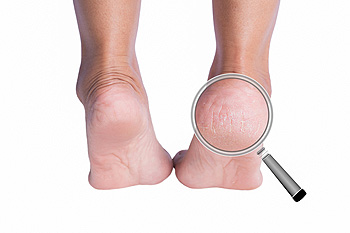
Cracked heels are a common foot condition characterized by the splitting of dry, thick skin on the heels. When only the outer layer of skin is affected, it may not be painful but can be uncomfortable. In more severe cases, the cracks can extend into the healthy skin, causing pain, bleeding, and infection risk. Several factors contribute to cracked heels, including prolonged standing, wearing unsupportive footwear, and biomechanical issues. Additionally, taking hot showers, increase in weight, and medical conditions such as diabetes may contribute to developing cracked heels. They are often more prevalent in the summer due to wearing open-back shoes and warm weather. Symptoms of cracked heels often include discomfort, pain while standing, itchiness, and dry, white skin on the heels. Treatment involves removing the dry skin, addressing underlying problems or infections, and preventing recurrence. Prevention strategies include regular callus removal, daily moisturizing, and wearing appropriate footwear. If you are suffering from cracked heels and they are not responding to everyday foot care, it is suggested that you consult a podiatrist for a specialized treatment plan.
If the skin on your feet starts to crack, you may want to see a podiatrist to find treatment. If you have any concerns, contact Dr. John P. Beaupied from Palos Podiatry. Our doctor can provide the care you need to keep you pain-free and on your feet.
Cracked Heels
It is important to moisturize your cracked heels in order to prevent pain, bleeding, and infection. The reason cracked heels form is because the skin on the foot is too dry to support the immense pressure placed on them. When the foot expands, the dry skin on the foot begins to split.
Ways to Help Heal Them
- Invest in a good foot cream
- Try Using Petroleum Jelly
- Ease up on Soaps
- Drink Plenty of Water
Ways to Prevent Cracked Heels
- Moisturize After Showering
- Skip a Shower
- Keep Shower Water Lukewarm
- Don’t Scrub Your Feet
If you are unsure how to proceed in treating cracked heels, seek guidance from a podiatrist. Your doctor will help you with any questions or information you may need.
If you have any questions, please feel free to contact our office located in Palos Heights, IL . We offer the newest diagnostic and treatment technologies for all your foot care needs.



